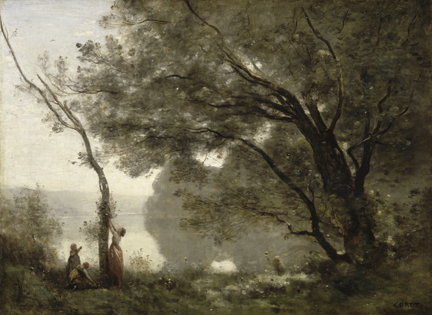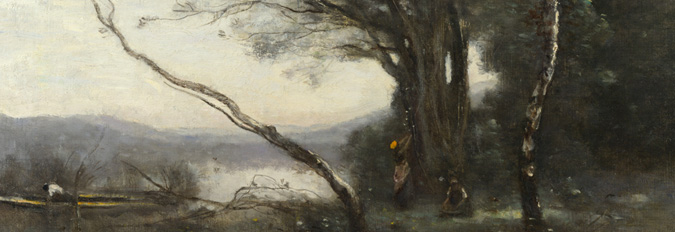Souvenir of Mortefontaine
These paintings are also closely related in both mood and motif to a further series, of which the most famous is 'Souvenir of Mortefontaine' (R1625, Paris, Musée du Louvre; fig. 6) exhibited by the artist at the Salon of 1864. Robaut dates the related paintings generally to the late 1860s and early 1870s8.

Musée du Louvre, Paris (MI692BIS) © RMN, Paris photo René-Gabriel Ojéda
Mortefontaine is a village to the north-east of Paris, known for its park and artificial lakes, created towards the end of the 18th century for Louis Le Peletier (1730–1799) who inherited the estate. In 1798 the estate was bought by Napoleon’s brother Joseph Bonaparte who made further additions. The grounds were refurbished in 1862, when the duc de Gramont built a new château in the ‘grand parc’. In the 1850s Corot painted some views of the area, although it has been suggested that 'Souvenir of Mortefontaine' itself and its related works can be seen as reminiscences of his views of the Italian lakes9.
However, there are distinct differences in composition between these two groups of paintings. In the foreground of 'Souvenir of Mortefontaine' the trunk and branches of the right-hand tree reach over to the left of the picture, while on the left a single tree stands alone. Its trunk stands straight, but its upper half echoes the movement of the mass of branches on the right. A woman and children gather around the tree, the woman reaching up to gather twigs or foliage.
The leaning branches of 'Souvenir of Mortefontaine' can also be traced back to a drawing made by Corot during his first visit to Italy in 1826, 'Torrent sous Bois, Civita Castellana' (R2505, Paris, Musée du Louvre), as has been noted by Bazin10. Claude and Japanese prints have also been suggested as possible sources for this motif11. Toussaint specifically places Souvenir de Mortefontaine in a short period where Corot became influenced by Japanese art. Corot took from Japan the idea of the screen in the foreground, in this case the trees, flattening the picture surface, through which one glimpses the distance12. This device is also present in the series to which 'The Leaning Tree Trunk' belongs.
Dating
Bazin defines the group to which NG 2625 belongs as coming after 'Souvenir of Mortefontaine': ‘We also see the theme [of 'Souvenir of Mortefontaine'] combined with a tall upright dead tree, born on the banks of the lake at Ville d’Avray (R1497 and 1498) and which, once discovered, served Corot again and again.’ 13
The dead tree refers to the prominent single upright trunk found on the right of these compositions, but in fact, as we have seen, this trunk is an exact copy of the upright tree on the right of the drawing cited above, 'Clump of Trees at Civita Castellana'14.
Other authors give dates that suggest that the series in which 'The Leaning Tree Trunk' plays a part came first. Marie-José Salmon lists NG 2625 and the Melbourne painting as the first idea in his list of variations (1855–70) on the theme of Mortefontaine15. Robaut dates 'The Leaning Tree Trunk' and the Melbourne painting to 1855–65, prior to or concurrent with 'Souvenir of Mortefontaine'.
In the most recent studies by Nathalie Michel and Vincent Pomarède the Reims picture has been given a date of 1860 to 1865, thus concurrent with 'Souvenir de Mortefontaine'. Although the Reims picture can indisputably be given first place in the series, it is perfectly feasible that Corot painted the variants, including NG 2625, in the first half, or possibly second half of the 1860s.
Copy
A copy signed ‘TH.R.’ was at Christie’s, South Kensington, 26 August 2004, lot 15316.
Previous owners
'The Leaning Tree Trunk' was in the collection of Alexander Young (1828–1907), an accountant in London who for many years headed the firm of Turquand, Young and Co17. In his day Young was considered the most discerning of the group of late nineteenth-century collectors who built up large collections of French and Dutch landscapes.
In 1906 he sold his entire collection to the dealer Agnew’s, who in turn sold the pictures privately to individuals, dealers and galleries. One of the buyers was George Salting (1836–1909), who comparatively late in his life added to his existing collection of Italian, Dutch and British pictures a group of French landscapes, almost all from the Young collection18. In 1907 he placed a number of these on loan to the Gallery, including The Leaning Tree Trunk, and this was among the pictures selected by the National Gallery when his collection was bequeathed in 1910.

